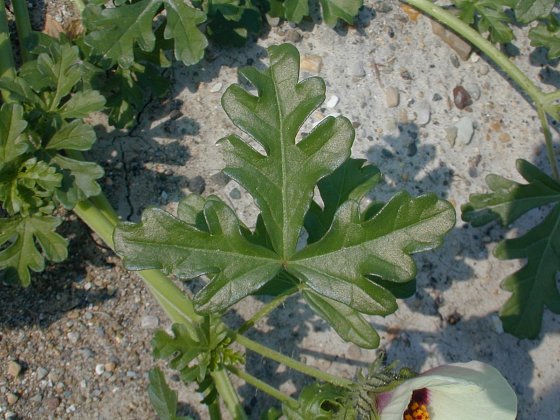Description: This plant is a summer annual that develops into a sprawling vine up to 1' tall. The stems are up to 2' in length, branching occasionally; they are round and hairy. The alternate leaves are up to 3" long and 2" across (excluding the petioles). They are deeply divided into 3 primary lobes. Each of these primary lobes is shallowly lobed, sometimes with a few large blunt teeth that are crenate or dentate along the margin. Among the primary lobes, the middle lobe is longer the side lobes. The hairy petiole is at least half as long as the leaf that it connects to the stem. From the axils of the leaves, there develops single flowers from hairy stalks. Each flower is about 2" across, consisting of 5 rounded petals that are white or pale yellow, a large calyx that is divided into 5 segments, a pistil with a divided style, and numerous stamens with golden yellow anthers. Each petal is purple at the base. The purple style is divided into 5 short stigmata with knobby tips. The segments of the calyx are pale green and membranous. Each calyx segment has several longitudinal nerves that are purple or green and hairy. At the base of each calyx, there are several spreading bracts that are slender.

The blooming
period occurs from mid-summer to early fall and lasts about 1-2 months.
Each flower blooms during a single day that is sunny, and remains open
for only a few hours. The oval seed capsule has 5 cells and is
completed enclosed by the papery segments of the calyx. Each cell
contains numerous seeds that are dull brown or grey, and kidney- or
heart-shaped. The root system is fibrous. This plant spreads by
reseeding itself.
Cultivation:
Flower-of-an-Hour typically grows in full sunlight and more or less
mesic conditions. It is found in various soil types, including sandy
soil, compacted clay, and loamy soil that has been recently cultivated.
The seeds germinate only after the soil warms up during the late spring
or early summer. They can remain viable in the soil for several years,
if not decades.

Range
& Habitat:
Flower-of-an-Hour is a common plant in central and northern Illinois,
but less common or absent in southern Illinois (see Distribution
Map). It was introduced into the United States from southern
Europe as an ornamental plant. Habitats include cropland, edges of
fields, areas along roadsides and railroads, gardens, vacant lots, and
construction sites. This is primarily a weed of cropland. The presence
of this plant in a city may be an indication that the site was an
agricultural field at some time in the past. Disturbed areas are
strongly preferred.
Faunal Associations:
The flowers are pollinated by bumblebees primarily. Smaller bees and
butterflies visit the flowers occasionally for nectar or pollen. The
caterpillars of some Lepidoptera feed on members of the Mallow family,
including Anomis erosa (Yellow Scallop Moth), Pyrgus
communis (Common Checkered Skipper), Strymon melinus
(Gray Hairstreak), and Vanessa cardui (Painted
Lady). The foliage is non-toxic and probably eaten by livestock and
rabbits. Apparently birds make little use of the seeds.

Photographic
Location:
A vacant lot in Urbana, Illinois.
Comments:
This member of the Mallow family has a distinctive appearance because
of its deeply lobed leaves. Other mallows usually have
leaves that are unlobed or shallowly lobed. The beautiful flowers are
large, considering the small size of the plant, but they remain open
for only
a short time. Another common name for this species is Venice Mallow.